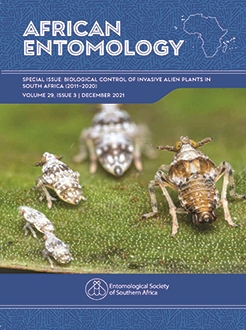Biological control programmes against the asteraceous weeds Tithonia rotundifolia (Mill.) S.F. Blake and Tithonia diversifolia (Hemsl.) A. Gray were initiated in South Africa in 2007, and that against Tithonia tubaeformis (Jacq.) Cass in 2017, following its discovery in Mpumalanga Province (MP). Permission to release two leaf-feeding beetles, Zygogramma signatipennis Stål and Zygogramma piceicollis Stål (Chrysomelidae) against T. rotundifolia was granted in 2014, while permission to release a defoliating tortoise beetle, Physonota maculiventris Stål, against T. diversifolia was granted in 2018. The two Zygogramma spp. were released in Gauteng (GP), KwaZulu-Natal (KZN), Limpopo (LP), and MP provinces from 2014 to 2019. Zygogramma signatipennis established at only a few sites in MP, where it persisted for up to four years and later collapsed. Zygogramma piceicollis initially established in GP and perished a year later. Physonota maculiventris was released in KZN, LP and MP, and has overwintered at 50% of the release sites. Investigations to explain the demise of both Zygogramma spp. and determine ways to improve their release and establishment are underway. Host-specificity testing of a stem-boring weevil, Lixus fimbriolatus Boheman (Curculionidae), a candidate agent for T. rotundifolia, was successfully completed. An application for permission to release the weevil will be submitted to the regulatory authorities in due course. Additional host-specificity testing of agents for T. diversifolia has prioritised a leaf-mining moth, Melanocinclis sp. (Cosmopterigidae) for further assessment, while a leaf-feeding plume moth, Hellinsia sp. (Pterophoridae), and a stem-boring moth, Suleima skinnerana (Heinrich) (Tortricidae), were rejected. Investigations to determine the full identity, origin and host range of a leaf-sucking lace bug (Hemiptera: Tingidae), discovered on T. diversifolia in KZN, LP and MP, are underway. Surveys in climate-matched regions of the Central American native range of the target Tithonia spp. are imperative to identify natural enemies that may be more adaptable to persist across the plants' distribution in South Africa.
How to translate text using browser tools
31 December 2021
Biological Control of Tithonia spp. (Asteraceae) in South Africa: Challenges and Possibilities
K.V. Mawela,
D.O. Simelane
ACCESS THE FULL ARTICLE
It is not available for individual sale.
This article is only available to subscribers.
It is not available for individual sale.
It is not available for individual sale.

African Entomology
Vol. 29 • No. 3
December 2021
Vol. 29 • No. 3
December 2021
Agent establishment
invasive plants
natural enemies
Physonota maculiventris
weed distribution
Zygogramma spp





